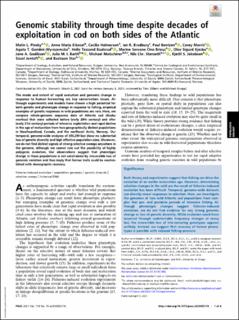| dc.contributor.author | Pinsky, Malin L | |
| dc.contributor.author | Eikeset, Anne Maria | |
| dc.contributor.author | Helmerson, Cecilia | |
| dc.contributor.author | Bradbury, Ian R. | |
| dc.contributor.author | Bentzen, Paul | |
| dc.contributor.author | Morris, Corey | |
| dc.contributor.author | Gondek, Agata | |
| dc.contributor.author | Baalsrud, Helle Tessand | |
| dc.contributor.author | Brieuc, Marine Servane Ono | |
| dc.contributor.author | Kjesbu, Olav Sigurd | |
| dc.contributor.author | Godiksen, Jane Aanestad | |
| dc.contributor.author | Barth, Julia Maria Isis | |
| dc.contributor.author | Matschiner, Michael | |
| dc.contributor.author | Stenseth, Nils Christian | |
| dc.contributor.author | Jakobsen, Kjetill Sigurd | |
| dc.contributor.author | Jentoft, Sissel | |
| dc.contributor.author | Star, Bastiaan | |
| dc.date.accessioned | 2021-10-22T12:33:17Z | |
| dc.date.available | 2021-10-22T12:33:17Z | |
| dc.date.created | 2021-10-19T21:21:51Z | |
| dc.date.issued | 2021 | |
| dc.identifier.issn | 0027-8424 | |
| dc.identifier.uri | https://hdl.handle.net/11250/2825029 | |
| dc.description.abstract | The mode and extent of rapid evolution and genomic change in response to human harvesting are key conservation issues. Although experiments and models have shown a high potential for both genetic and phenotypic change in response to fishing, empirical examples of genetic responses in wild populations are rare. Here, we compare whole-genome sequence data of Atlantic cod (Gadus morhua) that were collected before (early 20th century) and after (early 21st century) periods of intensive exploitation and rapid decline in the age of maturation from two geographically distinct populations in Newfoundland, Canada, and the northeast Arctic, Norway. Our temporal, genome-wide analyses of 346,290 loci show no substantial loss of genetic diversity and high effective population sizes. Moreover, we do not find distinct signals of strong selective sweeps anywhere in the genome, although we cannot rule out the possibility of highly polygenic evolution. Our observations suggest that phenotypic change in these populations is not constrained by irreversible loss of genomic variation and thus imply that former traits could be reestablished with demographic recovery. | en_US |
| dc.language.iso | eng | en_US |
| dc.title | Genomic stability through time despite decades of exploitation in cod on both sides of the Atlantic | en_US |
| dc.type | Peer reviewed | en_US |
| dc.type | Journal article | en_US |
| dc.description.version | publishedVersion | en_US |
| dc.source.journal | Proceedings of the National Academy of Sciences of the United States of America | en_US |
| dc.identifier.doi | 10.1073/pnas.2025453118 | |
| dc.identifier.cristin | 1947146 | |
| dc.relation.project | Norges forskningsråd: 221734/O30 | en_US |
| dc.relation.project | Norges forskningsråd: 203850/E40 | en_US |
| dc.relation.project | Norges forskningsråd: 262777 | en_US |
| cristin.ispublished | true | |
| cristin.fulltext | original | |
| cristin.qualitycode | 2 | |
